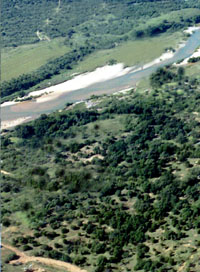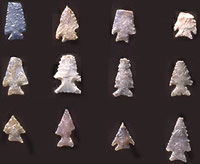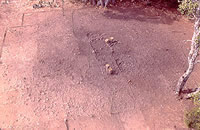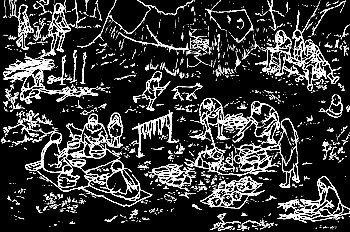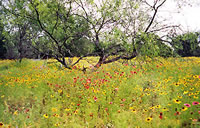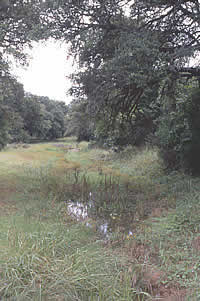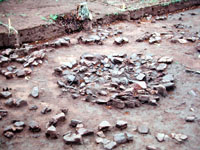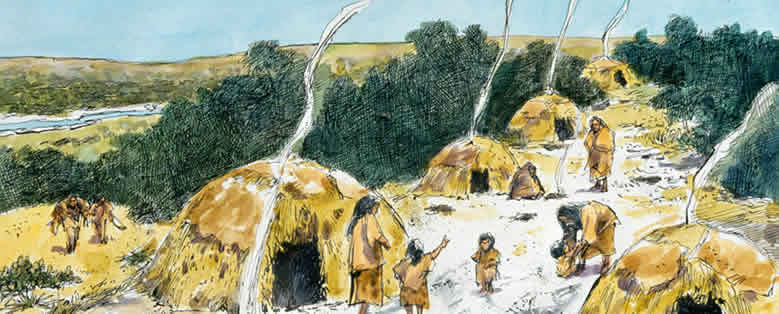
|
|||||||||
|
In the rolling granite hills near the confluence of the Llano and Colorado Rivers, the remains of a thousand-year-old Indian village, or rancheria, have come to light through excavations by the Llano Uplift Archeological Society. Named Graham-Applegate after the present-day landowners, the site offers a glimpse into the lives of a little-known Indian people who called central Texas home at the turn of the first millennium A.D. Their culture vanished—or blended with that of later groups—several centuries before the earliest Spanish expeditions entered the region. No written account exists that could tell us who these people were, what language they spoke, or even what they called themselves. Archeologists refer to the culture of these people, and the time in which they lived, as the Austin phase. Earlier research has shown that the Austin phase was a time of tumultuous change for the people of central Texas. The period began around A.D. 700 with the introduction of the bow and arrow which supplemented, and eventually replaced, the atlatl and dart, an older weapon system which had been in use for thousands of years. The new weapon system—lighter, more deadly accurate, and easier to use in cramped quarters—undoubtedly disrupted the existing order already tense from population pressures, and probably initiated an era of violence reflected in the appearance of the first formal cemeteries in the region. Many of the individuals buried in these cemeteries died from arrow wounds, the evidence being corner-notched flint arrow points—of a type called "Scallorn" by archeologists— found embedded in and among their bones. The excavations at Graham-Applegate paint a somewhat different, more peaceful picture of Austin phase times. Situated on the lower reaches of a gentle slope, the rancheria is not well-positioned for defense. Judging from the features excavated there, the living areas and work areas are not all in close proximity to one another and may not even have been occupied at the same time. . Much time also was spent on the search for food and in its preparation within the rancheria. The ruins of a large earth oven once lined with granite boulders attests to the importance of plant foods for these people; perhaps they were baking large quantities of wild onions, a plant which still grows today in nearby arroyos in early spring. Granite was also used to construct smaller hearth-like grills for cooking freshwater mussels and other foods gathered or hunted from the wild. Numerous other cooking features have been uncovered as well. There is no evidence that these people ever practiced agriculture. Stone-tool making was an important endeavor at the rancheria. Most of the tools, such as arrow points and knives, were made of chert (flint) but at least one inhabitant was in possession of a tool made from volcanic glass or obsidian, an exotic material for these parts. Three obsidian flakes recovered from a lithic workshop area have been tentatively traced, using their chemical signature, to an outcrop in southwestern Utah over a thousand miles from the Graham-Applegate site. In our early interpretation of the site, it was thought that the stone features at Graham-Applegate were the remains of houses. The stone circles and pavements appeared to represent the foundations and floors of five hut-like structures swallowed up by the gravel-filled soils soon after they were abandoned by their owners. Prehistoric architectural features are rarely found (or, more accurately, recognized) in central Texas. Prior to the investigations at Graham-Applegate, only four prehistoric houses had been excavated in this region, so those at Graham-Applegate would more than double that number. Similar stone circles found in relatively large numbers along the eroding shorelines of area reservoirs are a reminder that many such features may lie buried, archeologically invisible until a chance discovery unveils them. What is a rancheria?Artist Peggy Maceo's conception of a village scene with multiple dwellings. Drawing
by Peggy Maceo, courtesy of the Lower Colorado River Authority.
From the late sixteenth through the eighteenth centuries, Spanish expeditions traveling north into Coahuila and Texas from central Mexico frequently encountered Indian settlements which they called rancherias. From the Spanish word rancho, with various meanings including hut or farm, rancheria implies a temporary settlement where the inhabitants lived in modestly constructed houses. A rancheria represents something more than a mere campsite, but less than a permanent village or pueblo. Archeologists have appropriated this word to refer to hunter-gatherer campsites such as Graham-Applegate that appear to contain traces of aboriginal dwellings. Only one definite rancheria has been excavated in central Texas. The Lion Creek site, located less than10 miles (16 kms) from Graham-Applegate on the eastern shore of Lake Buchanan in Burnet County, was excavated by the Texas Department of Transportation (TxDOT) in the late 1970s. There, the buried foundation remains of two houses and a third possible house were discovered and uncovered. One of the houses dated to the Austin phase and was probably occupied about the same time as the Graham-Applegate rancheria. The other two stone patterns, or "features," are earlier, apparently dating to the early part of the Late Archaic (based on the styles of projectile points found with them). A possible rancheria site was also excavated by TxDOT in 1980 only a mile (1.6 km) north of Graham-Applegate at a low-water crossing of the Llano River known as the "Slab." Unlike Graham-Applegate, the Slab site was visited by aboriginal peoples at many different times in the past, resulting in a complex living surface cluttered with many stone patterns. Most of these features, as depicted in drawings in the report, look like the small cooking hearths or fireplaces scattered about the Graham-Applegate rancheria. A few larger stone features could be central hearths but lack well-defined wall areas. Update: New InterpretationsIn our New Interpretations section, we consider an alternative view of the Graham-Applegate site based on data gleaned after this exhibit was originally written. The stone features at the site have now been identified as burned rock middens. We include both interpretations in this exhibit to show how archeological determinations are made, and the proccesses and techniques involved in those considerations. That the Graham-Applegate site reflects a campsite, or rancheria, is not in question. Clearly, Late Prehistoric peoples spent much time at the site in the labor intensive tasks of processing and cooking plant food in earthen ovens, as evidenced by the multiple burned rock middens. However, evidence of the ephemeral brush huts likely used by prehistoric campers apparently is lacking, and finding such remains continues to be a quest for many archeologists.
|
|
|||||||
